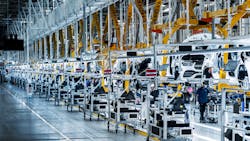Mercedes-Benz Works with NVIDIA to Create Digital Twins of Its Factories
This article appeared in Electronic Design and has been published here with permission.
Check out more of our CES 2023 coverage.
Mercedes-Benz is partnering with NVIDIA to create three-dimensional digital twins of its factories, in a bid to gain better visibility into its factory operations and optimize production layouts.
The automaker’s plan is to use NVIDIA’s Omniverse software to create virtual replicas of its physical plants, using the digital twins to design and plan manufacturing and assembly facilities more intelligently, said Danny Shapiro, head of NVIDIA’s automotive unit.
At CES 2023, Mercedes said it’s preparing to use the Omniverse platform to help upgrade its plant outside of Stuttgart, Germany, where the intent is to eventually start production of a new platform for electric vehicles.
The site is currently used to produce a wide range of compact car models. Working with NVIDIA, Mercedes aims to formulate a “digital first” planning process for the site that won’t disrupt its existing manufacturing.
Omniverse is NVIDIA’s open 3D development platform that can be used to create physically accurate digital twins of everything from factories to infrastructure to retail stores. It’s a pillar of the company’s plans to become a more potent player in the software market.
This isn’t the first time Mercedes has invested in NVIDIA’s hardware and software offerings. The automaker has said it plans to use NVIDIA’s Drive Orin SoC to control autonomous-driving features in vehicles to hit the market in 2024. On top of that, the company is applying NVIDIA's Drive Sim software in Omniverse to test and validate the self-driving features in the safety of software before deploying them in vehicles.
Now, Mercedes is expanding the use of Omniverse to its manufacturing plants, where it builds vehicles that require thousands of chips and other parts, all carefully assembled by thousands of workers moving in sync.
Benefits of Digital Twins
Creating a digital twin of an entire factory involves modeling every facet of the facility, from the physical vehicles rolling through the assembly, to the robots and other machinery, to the workers on the factory floor, said Shapiro. For Mercedes, the digital twin it’s building with NVIDIA will help optimize the layout of its production facilities in the event there’s the need to switch out components due to supply disruptions or add (or subtract) features in its vehicles.
When automakers want to roll out a new vehicle model, they need to update the layout of their factories to account for the new product design. This involves taking significant portions of the facility out of the loop, which can snag the production of existing vehicles. Omniverse will give the automaker the ability to virtually test and validate new factory layouts without having to interrupt its existing operations, said NVIDIA.
Using Omniverse, every proposed change to the auto maker’s factories can be evaluated in the digital twin and then tested and validated in the virtual world before being deployed to the physical facility.
NVIDIA is winning over a growing number of companies in areas ranging from retail, logistics, automotive, and manufacturing to Omniverse. But whether it’s worth it for these firms to continue using Omniverse hinges on its ability to create digital twins that accurately mimic their counterparts in the physical world.
To this end, the U.S. chip giant introduced a new hardware offering last year called OVX that’s specifically designed for customers hoping to create realistic digital replicas of their operations and product designs in Omniverse.
NVIDIA said it expects Mercedes to expand the digital twins powered by Omniverse to its other factories over time.
Check out more of our CES 2023 coverage.
About the Author

James Morra
Senior Editor
James Morra is the senior editor for Electronic Design, covering the semiconductor industry and new technology trends, with a focus on power electronics and power management. He also reports on the business behind electrical engineering, including the electronics supply chain. He joined Electronic Design in 2015 and is based in Chicago, Illinois.
